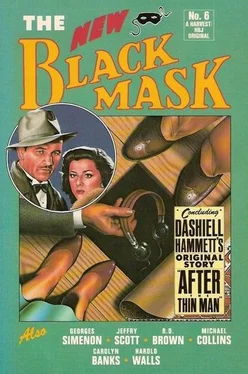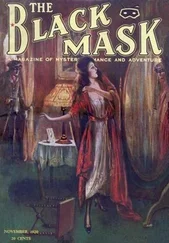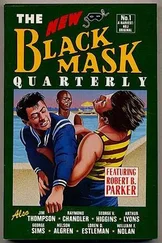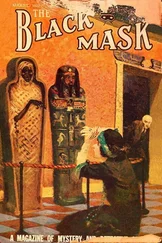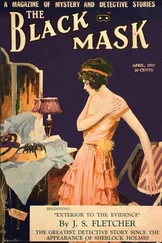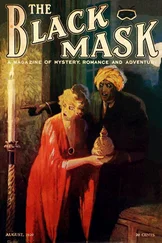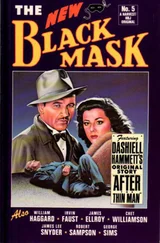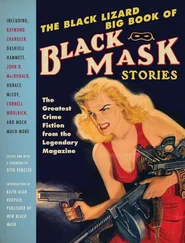Carolyn Banks - The New Black Mask (№6)
Здесь есть возможность читать онлайн «Carolyn Banks - The New Black Mask (№6)» весь текст электронной книги совершенно бесплатно (целиком полную версию без сокращений). В некоторых случаях можно слушать аудио, скачать через торрент в формате fb2 и присутствует краткое содержание. Город: New York, Год выпуска: 1986, ISBN: 1986, Издательство: A Harvest/HBJ book, Жанр: Детектив, на английском языке. Описание произведения, (предисловие) а так же отзывы посетителей доступны на портале библиотеки ЛибКат.
- Название:The New Black Mask (№6)
- Автор:
- Издательство:A Harvest/HBJ book
- Жанр:
- Год:1986
- Город:New York
- ISBN:978-0-15-665485-2
- Рейтинг книги:5 / 5. Голосов: 1
-
Избранное:Добавить в избранное
- Отзывы:
-
Ваша оценка:
- 100
- 1
- 2
- 3
- 4
- 5
The New Black Mask (№6): краткое содержание, описание и аннотация
Предлагаем к чтению аннотацию, описание, краткое содержание или предисловие (зависит от того, что написал сам автор книги «The New Black Mask (№6)»). Если вы не нашли необходимую информацию о книге — напишите в комментариях, мы постараемся отыскать её.
The New Black Mask (№6) — читать онлайн бесплатно полную книгу (весь текст) целиком
Ниже представлен текст книги, разбитый по страницам. Система сохранения места последней прочитанной страницы, позволяет с удобством читать онлайн бесплатно книгу «The New Black Mask (№6)», без необходимости каждый раз заново искать на чём Вы остановились. Поставьте закладку, и сможете в любой момент перейти на страницу, на которой закончили чтение.
Интервал:
Закладка:
The New Black Mask (№ 6)
“Georges Simenon: An Interview,” copyright © 1986 by Georges Simenon. “The Man Behind the Looking Glass,” originally published as “La cage d’Emile,” by Georges Simenon, copyright © 1943, Editions Gallimard, translated by Harold J. Salemson, copyright © 1986. “After the Thin Man,” by Dashiell Hammett, copyright © 1986 by MGM/UA Entertainment Co. “A Friend to the Limit,” copyright © 1986 by Jeffry Scott. “Frisbee in the Middle,” copyright © 1986 by R. D. Brown. “Mean to My Father,” copyright © 1986 by Carolyn Banks. “Killer’s Mind,” copyright © 1986 by Michael Collins. “It Was a Hard Fall,” copyright © 1986 by Harold Walls.
Georges Simenon: An Interview
Simenon (he long ago reached the level of eminence that renders honorifics superfluous) was born in Liège, Belgium, in 1903, and writes in French. His most famous creation, Inspector Maigret, first appeared in 1931; but the many Maigret stories account for a relatively small portion of the bountiful Simenon canon. His work is superbly readable because — among other qualities — of its economy and pace. He has pared his prose to its essentials. Beyond readability, he provides accurate observation of behavior: what his characters do is what they are.
Simenon agreed to answer questions for New Black Mask in writing, explaining: “I am in the habit of writing ‘short.’ But I am incapable of long dissertations.”
NBM: Certain critics insist that every great novelist has his own narrative “voice,” and that this voice provides the defining quality of his prose. If you agree with this claim, please describe your prose voice. Is it consistent or does it vary with the different types of your novels?
Simenon: Naturally, every novelist has his own style. I have always tried to make mine as simple as possible, with a minimum of adjectives and adverbs, a minimum of abstract words which have a different resonance for each reader. I use a maximum of mots matière.
The rhythm alone varies according to the subject, sometimes from one chapter to another.
NBM: Are your characters’ lives determined by forces — hereditary and environmental — over which they have no control? Or do you allow them the chance to alter their destinies?
Simenon: Very few people are capable of changing their destinies, but heredity, environment, and even climatic conditions play an important part in human behavior. A discussion between husband and wife on a lovely spring day will not have the same violence as in oppressive and thundery weather.
NBM: You have said that the purpose of your revisions is to remove the “literary” sentences. Yet you admire William Faulkner’s work. Isn’t he a highly literary writer?
Simenon: Faulkner was not considered as such when he started, so much so that he had to work in Hollywood to make a living, and if he was largely published and acclaimed in France, he had to discuss no end with his American publishers.
“Style is the reflection of man,” and Faulkner was a most complicated person. Fortunately for us.
NBM: Most of your worldwide readers know your work only in translation and so have read Simenon filtered through someone else. What rules would you like your translators to obey?
Simenon: To safeguard my simplicity. Which is difficult, as for instance in Italian.
NBM: Are there elements in your work that are untranslatable?
Simenon: It depends on the languages... and on the translators.
NBM: What qualities should your ideal reader possess?
Simenon: To read without trying to analyze.
NBM: When you were writing a novel, were you consciously aware of technique — or did the material shape your technique?
Simenon: I have always searched after simplicity. Boileau wrote: When you want to say it rains, say: “It rains.”
NBM: Did you see your characters’ faces as you wrote about them? Did you deliberately collect or save the faces that you observed?
Simenon: I have collected, or rather, unconsciously recorded, living characters which I used, sometimes years later.
NBM: As the most widely read living author, do you feel that your work has “universal qualities”? If so, what are the qualities that cut across the borders, languages, and cultures?
Simenon: Simplicity? Sincerity? I just don’t know.
NBM: If you were beginning your career in 1985 what kinds of novels would you try to write?
Simenon: I don’t know. Probably the same.
The Man Behind the Looking Glass
Georges Simenon
Translated by Harold J. Salemson
This marks the first publication in English of “The Man Behind the Looking Glass.” The story was published as “La cage d’Emile” in Simenon’s Les Dossiers de l’Agence “O” (Paris: Gallimard, 1943).
I
In which young lady swoons in the arms of sturdy Torrence, and in which we learn of the strange chain of command at the Agency.
Eleven A.M. The viscous fog to which Paris awakened is the kind you can tell won’t dissipate all day. The young lady has had her taxi stop in the Rue du Faubourg Montmartre, and dashes briskly into the Cité Bergère. There must be a rehearsal going on at the Palace Theater, for two or three dozen showgirls and chorines are pacing back and forth on the sidewalk outside.
Directly across from the stage door of the famous musical-revue theater, a hairdresser’s shop, its facade painted a gaudy purple: “Chez Adolphe.”
To the right, a small door, a dark corridor, a stairway with no concierge to stop you. An enamel nameplate, these words in black on white: “Agency O, Third Floor Left.”
The greatest of stage stars have gone through the portals across the street, and famous politicians, princes of royal lineage, and multimillionaires have been familiars of the Palace backstage.
How many of these same personalities, on mornings like this one, also sneaked in here, collars turned up, hats hiding their faces, up the stairs to Agency O?
At the third floor, the young lady stops for a moment and takes a mirror from her handbag. But not to check on her makeup. On the contrary, as she looks at herself, her face takes on an even more haunted expression.
She rings. A slow step is heard inside. The door is opened by a most unprepossessing clerk. The waiting room looks tacky. A newspaper on a small table. No doubt the clerk was just reading it.
“I would like to see the manager,” she says excitedly. “Would you please tell him it’s terribly important...”
And she dabs at her eyes with her handkerchief. The clerk must have seen many more like her, for he turns without hurry toward an inside door, disappears, comes back a little later, and just motions to her.
The next minute, the girl goes into the office of Joseph Torrence, a former inspector of Paris’ Criminal Division, now manager of Agency O, one of the most famous private detective agencies in the world.
“Please come in, mademoiselle,” he says. “Have a seat.”
Nothing could look more ordinary than this office in which so many terrifying secrets have been revealed. Nothing could be more reassuring than big old Torrence, an easygoing giant of a man in his late forties, looking very well groomed and well fed.
The window that looks out on the Cité Bergère has opaque panes. The walls are lined with bookshelves and files. Behind the mahogany desk, within Torrence’s easy reach, the kind of safe you might find in any business office anywhere.
“Excuse me, monsieur, if I seem a little nervous. You will understand, as soon as I fill you in... We’re all alone here, aren’t we?... I have just arrived from La Rochelle. All that happened there was just...”
Читать дальшеИнтервал:
Закладка:
Похожие книги на «The New Black Mask (№6)»
Представляем Вашему вниманию похожие книги на «The New Black Mask (№6)» списком для выбора. Мы отобрали схожую по названию и смыслу литературу в надежде предоставить читателям больше вариантов отыскать новые, интересные, ещё непрочитанные произведения.
Обсуждение, отзывы о книге «The New Black Mask (№6)» и просто собственные мнения читателей. Оставьте ваши комментарии, напишите, что Вы думаете о произведении, его смысле или главных героях. Укажите что конкретно понравилось, а что нет, и почему Вы так считаете.
